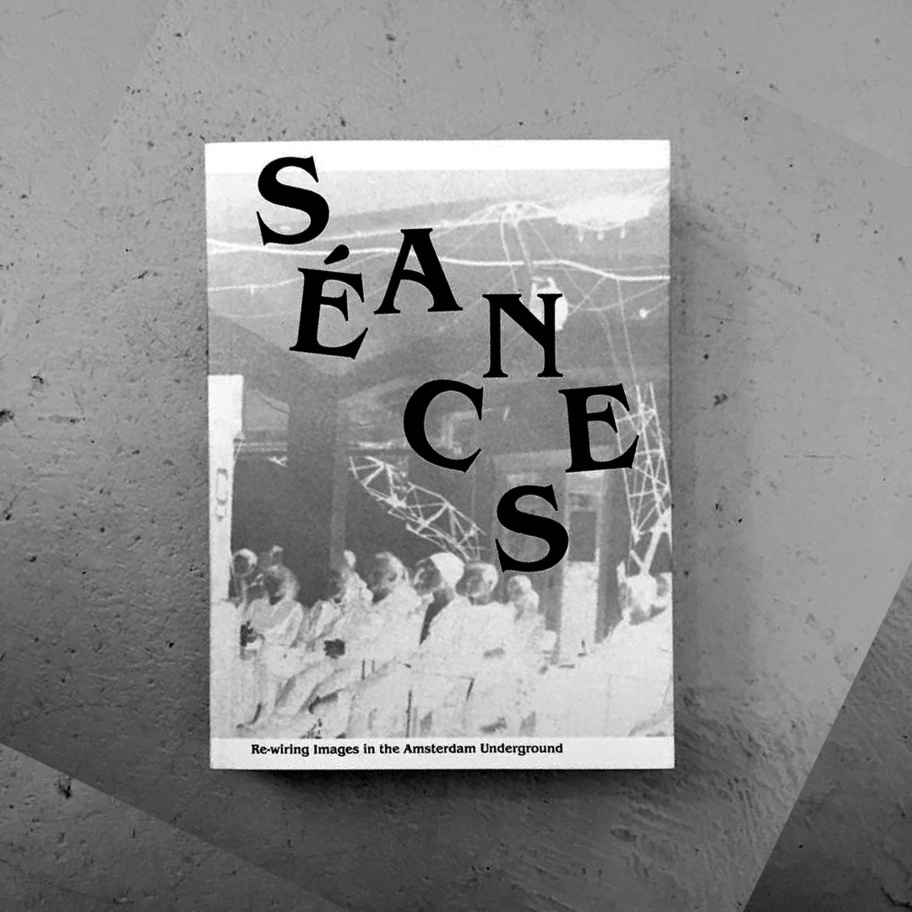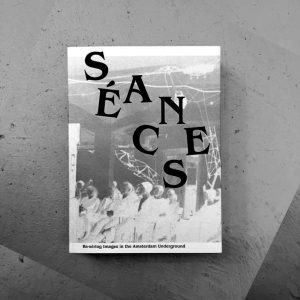Book Review – Seances: Re-wiring images in the Amsterdam Underground

Book Review – Seances: Re-wiring images in the Amsterdam Underground
E.T.C. Dee
2016, Self-published in an issue of 600 copies.
Jeffrey Babcock is well-known in Amsterdam for his underground cinema screenings, which take place in funky venues across the city, often in squats or alternative spaces. Now he has published with his partner Cecilia a fantastic book about the process of putting on these DiY film nights from 2006 to 2015 (and they continue into the present).
The book looks and feels great, with it’s black / grey / white look, fold-out cover, almost 400 pages and lots of illustrations, including a selection of flyers at the end. As sometimes happens, I actually felt bad making notes in the book since it is such a lovely object in its own right.
I read it cover to cover in on a long bus trip and thoroughly enjoyed it. Since I don’t live in Amsterdam I have only attended a few screenings myself, but to give an idea of the total number, a few years ago there were already over 1000. These veer from Performance, the hedonistic Sixties gone bad mess with Mick Jagger, to Svankmajer’s amazing hand-animated short films, from the shocking Punishment Park to cult Japanese films.
Jeffrey tends to give a rousing introduction to his often obscure films, preparing the audience a bit and giving a few insider notes.
Extracts from these speeches form the backbone of the book, with interviews, photographs, jottings and short tributes scattered throughout. It might be thought boring to hear about these often neglected films one after the other, but the enthusiasm is infectious and there are lots of good stories.

A good proportion of the book is rants about various subjects, such as standing up to racist police, lamenting the disappearance of cinema spaces, singing the joys of staying nomadic, keeping ticket prices free or fairly priced, bemoaning the gentrification of the Amsterdam Film Museum (now the EYE), exposing the blandness of Hollywood (“a shrewd industrial complex”) and mourning the death of 35mm as everything goes digital. This is one of the foremost reasons I enjoyed the book, since I also care a lot about most of these topics. I’m not sure how much I would I necessarily agree with Jeffrey on all of them, however that is not the point, since he wants to provoke debate.
One thing where we would definitely have a long discussion is concerning the necessity of watching films in the cinema, as opposed to on the laptop at home. Jeffrey takes the cinephile view that films have to be seen on the big screen. Whilst I do love to go to the cinema, I also very much enjoy watching films on the laptop from the comfort of my own sofa, with a cat sitting on my legs. A recent pleasure has been sitting down at home every Monday to watch the latest downloaded episode of Twin Peaks Season 3 as dusk falls.
Another reason I liked Seances a lot is that it is documenting the efforts of do it yourself, anti-capitalist culture, with a healthy dose of introspection thrown in. On the underground, Jeffrey has this to say:
The underground is a continuity issue. It’s about siding with the bloodline of culture and the backbone of history, rather than selling out to make a quick buck. It’s about long-term principles rather than short-term gains, about imagining your own rules. The underground is a plunge into exploration, experimentation, and taking risks… it’s about choosing the big adventure. It is decapit(aliz)ation in the sense of not allowing everything to revolve around finance, not allowing money to influence every aspect of life.
In total, twenty eight venues for the film nights are described. For me the most interesting ones to hear about were squats like Joe’s Garage, Leidsbezet, Spinhuis and Schijnheilig, and legalised squats like Nieuwe Anita and Budapest. The book ends with an account of the recent student occupations (Spinhuis, Bungehuis and Maagdenhuis). Jeffrey helped out by beaming bizarre films like BruceLaBruce’s hilarious Raspberry Reich. In fact the book ends with the squatting of a new amazing space under a bridge in the centre, an optimistic way to finish, showing that the fight for autonomous spaces in Amsterdam is not completely over. (Inevitably, this social centre has now been evicted).
Lastly, this book is a call to keep Amsterdam weird, to fight for and preserve the many quirky places, often with roots in the squat scene, that still make Amsterdam such an attractive place. It seems fitting that I picked up Seances at a bookfair in the city celebrating 15 years of an anarchist library.
